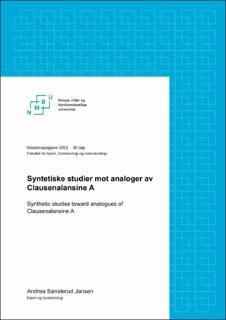| dc.contributor.advisor | Hansen, Trond Vidar | |
| dc.contributor.advisor | Antonsen, Simen | |
| dc.contributor.advisor | Stenstrøm, Yngve Henning | |
| dc.contributor.author | Jansen, Andrea Sønsterud | |
| dc.date.accessioned | 2022-02-16T10:09:07Z | |
| dc.date.available | 2022-02-16T10:09:07Z | |
| dc.date.issued | 2022 | |
| dc.identifier.uri | https://hdl.handle.net/11250/2979305 | |
| dc.description.abstract | Karbazolalkaloider er en type sekundære metabolitter som har vist seg å inneha viktige biologiske aktiviteter. De er derfor svært interessante i utviklingen av nye legemidler. Clausenalansine A er et karbazolalkaloid som har blitt isolert fra sitrusplanten Clausena lansium tilhørende planteslekten Clausena. Det er kjent at dette naturstoffet besitter nevrobeskyttende egenskaper. Clausenalansine A er derfor interessant å bruke som et utgangspunkt i utvikling av legemidler mot nevrodegenererende sykdommer slik som Parkinsons sykdom og Alzheimers sykdom. I denne oppgaven ble det arbeidet med en syntese mot analoger av Clausenalansine A.
Det ble først gjort en beskyttelse av 4-bromfenol med beskyttelsesgruppen tertbutyldifenylsilyl. Reaksjonen resulterte i (4-bromfenoksy)(tert-butyl)difenylsilan (1) med et utbytte på 83%. Denne ble reagert videre med kommersielt tilgjengelig 3-metoksyanilin (2) i en Buchwald-Hartwig aminering som resulterte i N-(4-((tert-butyldifenylsilyl)oksy)fenyl)-3- metoksyanilin (3) med et utbytte på 91%.
Neste steg i syntesen var en C-C oksidativ krysskobling for dannelse av 6-((tertbutyldifenylsilyl) oksy)-2-metoksy-9H-karbazol (4). Denne reaksjonen har blitt utført gjentatte ganger der det er blitt gjort endringer i reaksjonsbetingelser og ekvivalenter. Reaksjonene har enten vært mislykkede eller gitt lave utbytter. Det som derimot viste seg å gi et signifikant bedre utbytte var å bruke mikrobølgeoppvarming i stedet for konvensjonell termisk oppvarming. Det ble utført en rekke optimaliseringsforsøk på mikrobølgeovn med variasjon av både temperatur og tid der 140 oC i 1 time ga det beste utbyttet på 79%.
Det ble videre gjort en kløving av metyleteren som resulterte i 6-((tertbutyldifenylsilyl) oksy)-9H-karbazol-2-ol (5). Denne reaksjonen har tidligere blitt utført på liten skala med godt utbytte. Denne gangen ble reaksjonen utført på stor skala, noe som ga utfordringer med opprensning via flash kromatografi.
Det ble til slutt prøvd å gjøre en orto-formylering på forbindelse 5 som dessverre ikke var vellykket. | en_US |
| dc.description.abstract | Carbazole alkaloids are a type of secondary metabolites which possess important biological activities. For that reason, they are very interesting for the development of new pharmaceuticals. Clausenalansine A is an example of such a carbazole alkaloid. It has been isolated from Clausena lansium, a citrus plant belonging to the genus Clausena. It is known that this natural product possesses neuroprotective activity. Clausenalansine A is thus interesting as a starting point for the development of pharmaceuticals for neurodegenerative diseases like Parkinson’s disease and Alzheimer’s disease. In this thesis, a synthesis toward analogues of Clausenalansine A has been investigated.
At first, 4-bromophenol was protected with the tert-butyldiphenylsilyl protecting group. The resulting (4-bromophenoxy)(tert-butyl)diphenylsilane (1) was then coupled with 3- methoxyaniline (2) in a Buchwald- Hartwig amination reaction. This resulted in N-(4-((tertbutyldiphenylsilyl)oxy)phenyl)-3-methoxyaniline (3) in a yield of 91%.
The next step in the synthesis was a C-C oxidative cross-coupling to form 6-((tertbutyldiphenylsilyl)oxy)-2-methoxy-9H-carbazole (4). This reaction has been carried out several times, in which changes in the reaction conditions and equivalents were made. These reactions have either been unsuccessful or given low yields. However, the yield was significantly enhanced by using microwave heating instead of conventional thermal heating. Several optimization attempts were made with variations regarding both temperature and time where 140 oC for 1 hour gave the best yield of 79%.
The next reaction was the cleavage of the methyl ether which gave 6-((tertbutyldiphenylsilyl)oxy)-9H-carbazol-2-ol (5). This reaction has been carried out before at a low scale resulting in good yields. This time it was done on a larger scale, which caused some problems regarding the purification with flash chromatography.
Finally, an ortho-formylation on compound 5 was attempted, but the reaction was unfortunately unsuccessful. | en_US |
| dc.language.iso | nob | en_US |
| dc.publisher | Norwegian University of Life Sciences, Ås | en_US |
| dc.rights | Attribution-NonCommercial-NoDerivatives 4.0 Internasjonal | * |
| dc.rights.uri | http://creativecommons.org/licenses/by-nc-nd/4.0/deed.no | * |
| dc.title | Syntetiske studier mot analoger av Clausenalansine A | en_US |
| dc.title.alternative | Synthetic studies toward analogues of Clausenalansine A | en_US |
| dc.type | Master thesis | en_US |
| dc.description.localcode | M-KB | en_US |

